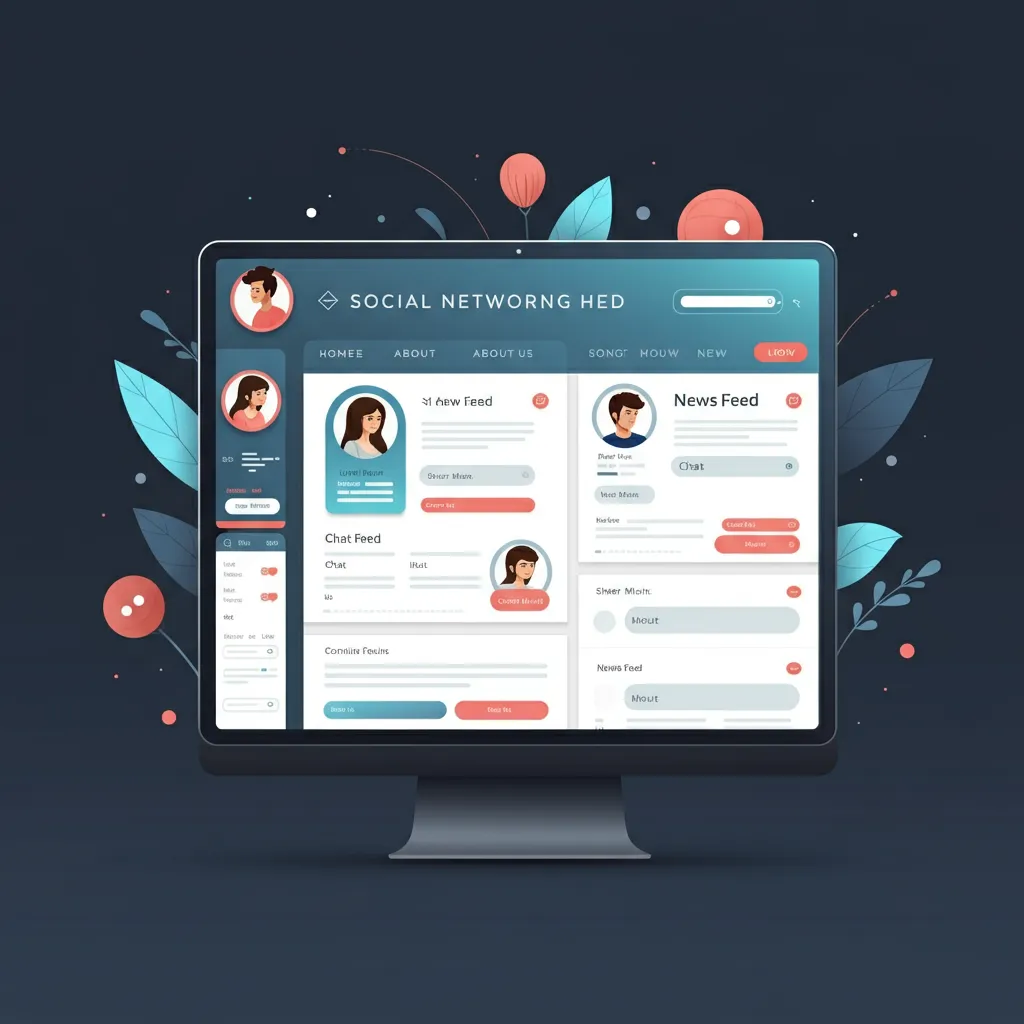Social networking websites have transformed the way people connect, share, and interact online. Whether it's a media-sharing platform like Instagram, a professional hub like LinkedIn, or a niche hobby network, these platforms hold immense potential for businesses and individuals alike.
With over 5 billion active internet users globally, the demand for social networking platforms continues to grow exponentially. But how do you develop a social networking website that stands out in this competitive arena?

This guide explores the ins and outs of creating a social networking website from scratch, ensuring you have the tools, strategies, and insights necessary for success.
From ideation to maintenance, we’ll walk through each critical step while pointing out often-overlooked aspects like scalability and security.
Types of Social Networking Websites
Before jumping into the development process, it’s essential to understand the different types of social networking platforms that dominate the market. Knowing where your idea fits will shape the direction of your project.
1. Media-Sharing Platforms
Platforms like Instagram, YouTube, and TikTok focus on user-generated media such as photos, videos, and music.
These websites are powered by rich content and offer features like live streaming and content recommendations to keep audiences engaged.
2. Professional Networks
Applications like LinkedIn serve professionals looking to network, share expertise, and discover opportunities. They emphasize career growth, allowing users to create profiles showcasing their skills and achievements.
3. Hobby-Based Communities
Sites like Pinterest and Behance are built around users’ hobbies and creative pursuits. They allow people with shared interests—such as photography or design to connect and exchange ideas.
4. Informational Platforms
Examples include Quora and Reddit, which center around answering questions and fostering discussions on specific topics. These networks thrive on user interaction and community-driven value.
5. Niche Social Networks
These cater to targeted groups with unique needs. Examples include academic platforms like ResearchGate or dating websites like Bumble. Their strength lies in their specialized focus, offering features tailored to specific user groups.
Each type comes with its own set of requirements and user expectations, so selecting a category aligned with your vision is crucial.
Learn more about How to Make a Social Networking App.
Step-by-Step Guide to Building a Social Networking Website

Creating a successful social networking website involves meticulous planning and execution. Below is a comprehensive roadmap to guide you through the process.
1. Idea and Concept
A solid idea is the foundation of your social network. To generate and validate your concept:
● Analyze gaps in the market. What value can your platform bring that existing platforms do not?
● Consider niche audiences or unique use cases that appeal to specialized groups.
● Validate your idea by conducting surveys or focus groups. Gathering user feedback early on ensures your concept resonates with your target audience.
2. Target Audience
Understanding your audience is non-negotiable. Define who they are by outlining demographics like age, location, interests, and challenges. For instance:
● Are you targeting young professionals in creative industries?
● Does your audience want streamlined networking for remote collaborations or hobby discussions?
Insights into your audience’s needs will influence everything from design choices to marketing strategies.
3. Strategy
Business Strategy: Determine your platform’s purpose and mission. Are you focused on community-building, knowledge sharing, or entertainment?
Monetization Plan: Social networks generate revenue in multiple ways:
● Advertisements: Sponsored posts and banner ads.
● Subscriptions: Premium plans offering exclusive features.
● Paid Features: Special tools like analytics or promotion for user-generated content.
Draft a roadmap that aligns with your long-term vision and includes financial sustainability.
4. Choosing a Tech Stack
Your tech stack forms the backbone of your website. The choice of technologies will affect your site's scalability, security, and user experience.
Front-End Recommendations:
● Frameworks like React or Vue.js for intuitive user interfaces.
● HTML5 and CSS3 for responsive design.
Back-End Technologies:
● Node.js for server-side applications or Django for high scalability.
● Ruby on Rails for data-heavy functionalities.
Database Solutions:
● PostgreSQL or MongoDB to manage user data efficiently.
● Consider cloud storage solutions like Amazon S3 for storing media files.
5. UI/UX Design

A seamless and engaging interface can make or break user retention. Steps for effective UI/UX design include:
● Wireframing: Outline the structure of your web pages.
● Prototyping: Create a clickable prototype to test user flows.
● Mobile Responsiveness: Ensure layouts adapt well to devices of all sizes.
Always prioritize simplicity and user-friendliness. For example, a "one-tap" login process can significantly enhance the user experience.
6. Development
Initially, focus on building a Minimum Viable Product (MVP) containing essential features:
● User Profiles: Allow users to customize their public-facing information.
● Chat System: Enable private and group messaging.
● News Feed: Aggregate updates from user connections.
● Search and Filters: Make it easy for users to locate one another.
● Notifications: Keep users informed of activity in real time.
Iterate and expand based on ongoing user feedback.
7. Testing and Launch
Rigorous pre-launch testing can prevent costly mistakes. Key testing phases include:
● Functional Testing: Ensure core features like sign-up, chat, and media uploads work as expected.
● Performance Testing: Can your platform handle a sudden increase in users?
● Security Testing: Protect user data with encryption and secure authentication processes.
After testing, launch your platform with a well-thought-out marketing campaign. Leverage social media ads, influencer collaborations, and emails to attract your first wave of users.
8. Maintenance
Post-launch, your platform should evolve continually:
● Monitor performance to optimize speed and uptime.
● Address user feedback swiftly, prioritizing new feature requests over time.
● Scale server resources as user numbers grow. For instance, moving to cloud hosting solutions like AWS ensures your platform accommodates demand spikes.
9. Critical Missing Points to Address
Unlike many guides, here are vital but often-overlooked aspects to consider:
● Scalability: Build server architecture that grows with user demand.
● Security: Implement features like two-factor authentication and SSL encryption to protect user data.
● Mobile Responsiveness: Over 55% of internet users access the web via mobile. Optimize for smaller screens or develop a complementary mobile app.
Final Thoughts and Call-to-Action
Developing a social networking website requires a balance of innovation, strategy, and execution. Whether you’re targeting a niche market or aiming to compete with global giants, following this roadmap ensures a smoother development process.
For professional assistance with custom social networking website development, visit newweborder.co to start your project today!
Looking for more tips on social media platform development? Stay updated as we unveil advanced strategies to dominate the digital landscape.
Social Network Development FAQ
1. Why should I invest in developing a social networking website?
Investing in a social networking website allows you to tap into a thriving digital market. With over 5 billion internet users and increasing time spent online, platforms that connect people offer immense revenue potential.
Whether you aim to build a niche community, enhance brand engagement, or monetize user activity, a social network offers opportunities for sustainable growth and direct user interaction.
2. What are the essential features of a social networking website?
A successful social networking platform should include:
● User Profiles: Allow users to create and customize their profiles.
● Search and Filters: Help users find people, groups, or content easily.
● News Feed: Aggregate content updates in a user-friendly format.
● Chat System: Enable private and group messaging.
● Notifications: Notify users of updates like comments, messages, or friend requests.
● Admin Panel: Monitor user activity, manage content, and enforce rules.
You can add additional features like media sharing or interest-based groups based on your platform’s focus.
3. How much does it cost to build a social networking website?
The cost of developing a social networking platform varies depending on the project's scope, features, and complexity. On average:
● MVP Development: Starts from $50,000 and can take 3–6 months.
● Full-Scale Platform: Can exceed $100,000, depending on advanced features, technologies, and customizations.
Engaging a professional development team ensures better cost efficiency and quality.
4. How long does it take to develop a social networking platform?
The timeline depends on the platform's complexity:
● MVP Development: Typically takes 3–6 months.
● Full-Featured Platform: May take 9–12 months or more for extensive customization and testing.
Clear requirements and a skilled development team can significantly streamline the process.
5. What technologies are best for building a social networking website?
For optimal performance and scalability, consider:
● Front-End: React.js, Angular, or Vue.js for a dynamic and responsive user interface.
● Back-End: Node.js, Ruby on Rails, or Django for robust server-side functionality.
● Database Management: PostgreSQL or MongoDB for secure and efficient data storage.
● Cloud Hosting: AWS, Google Cloud, or Azure to handle growing user traffic.
Choosing the right tech stack ensures a stable and scalable platform.
6. How can I ensure the security of my social networking website?
Implement the following security measures:
● Use SSL encryption to protect sensitive user data.
● Enable two-factor authentication (2FA) for user accounts.
● Regularly update software to address vulnerabilities.
● Employ secure coding practices to prevent common threats like SQL injection.
● Conduct regular security audits to identify and fix potential risks.
7. What is the importance of scalability in social networking platforms?
Scalability ensures that your platform can handle an increasing number of users and activities without performance issues. A scalable architecture allows you to:
● Add features as your user base grows.
● Expand server capabilities to manage traffic spikes.
● Maintain platform speed and reliability during high user activity.
This is particularly critical for long-term growth and user retention.
8. Should I build a mobile app alongside the website?
Yes, offering a mobile app alongside your website enhances accessibility and user engagement. Over half of internet access occurs via mobile devices, so a mobile-optimized platform or a dedicated app ensures a better user experience.
Starting with a responsive web design is a cost-effective approach if resources are limited.
9. How do I monetize a social networking website?
There are several monetization strategies:
● Advertisements: Banner ads, sponsored posts, and influencer collaborations.
● Subscriptions: Offer premium plans with exclusive features.
● Paid Features: Charge users for special tools or additional services.
● Content Locking: Allow creators to sell content, with a commission for the platform.
Experiment with various strategies to find what works best for your target audience.
10. Can I start with an MVP and expand later?
Absolutely! Building a Minimum Viable Product (MVP) allows you to launch quickly with core features (e.g., user profiles, chat, and a news feed). This helps you test your idea and collect user feedback without significant initial investment.
Based on feedback, you can iteratively add advanced features and refinements, ensuring better resource allocation.
For professional support in bringing your social networking vision to life, visit newweborder.co today!


